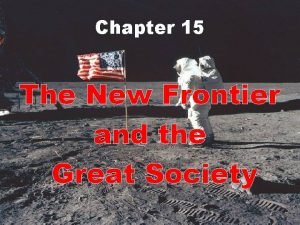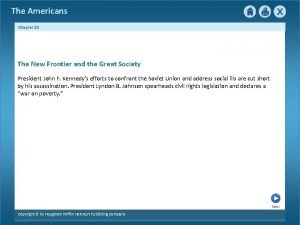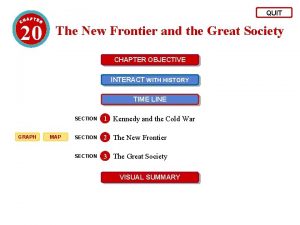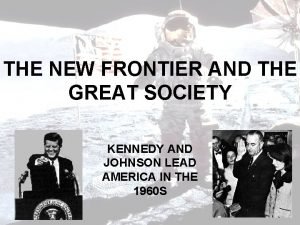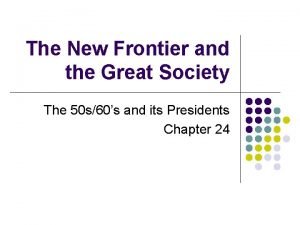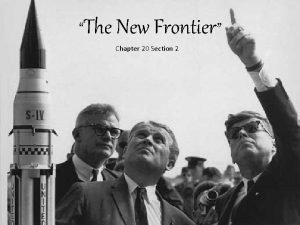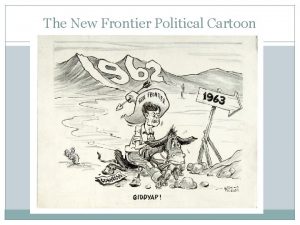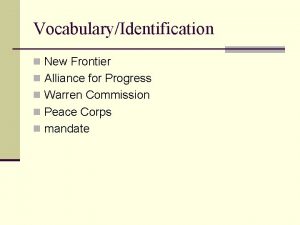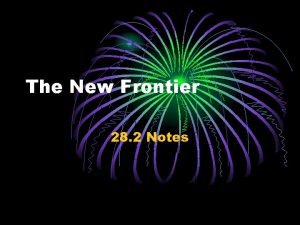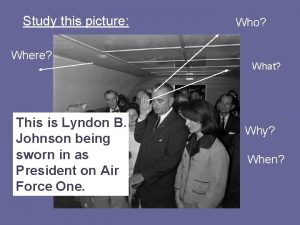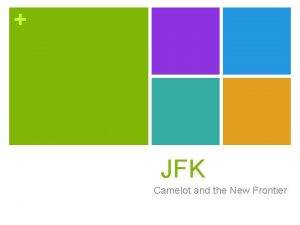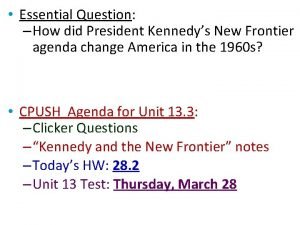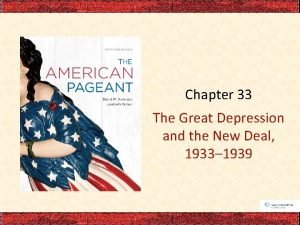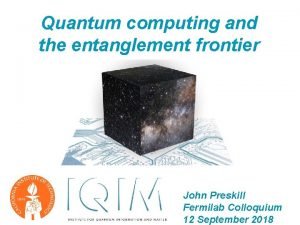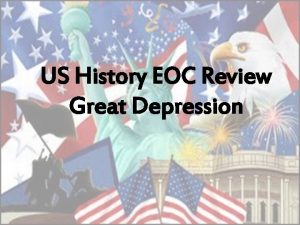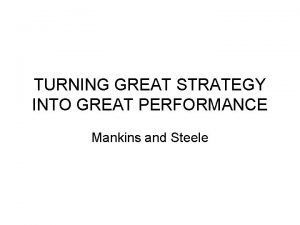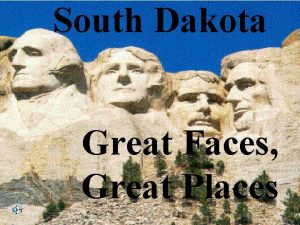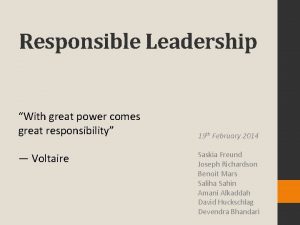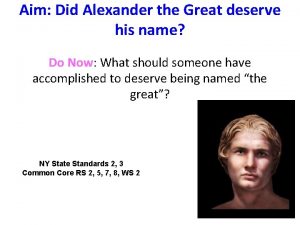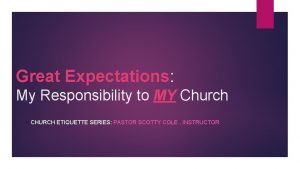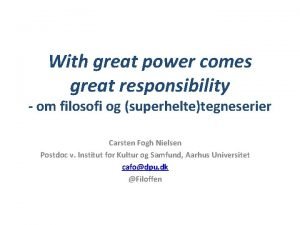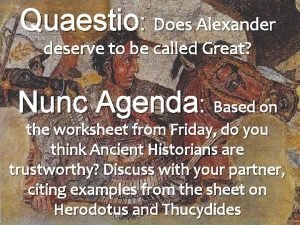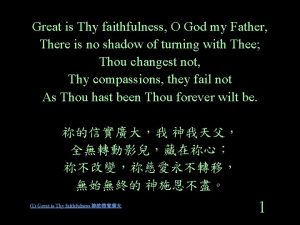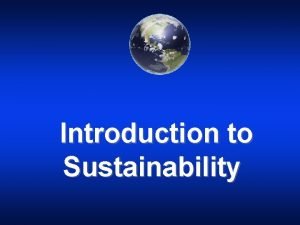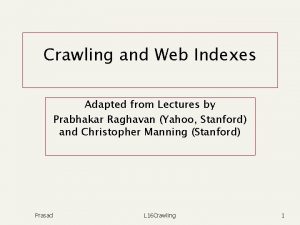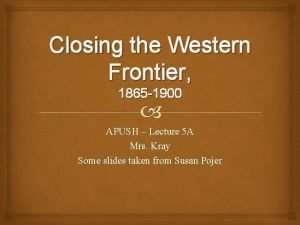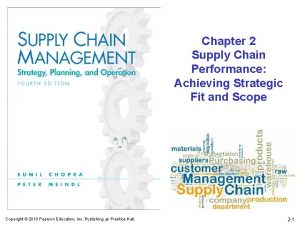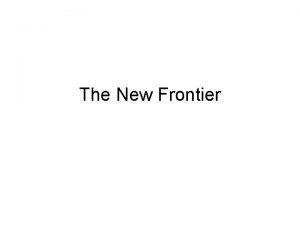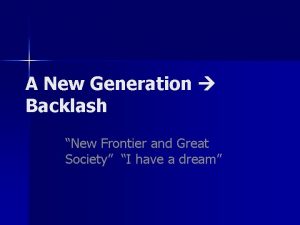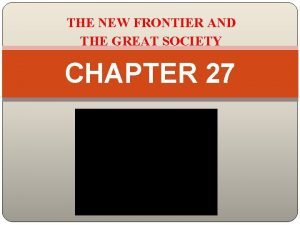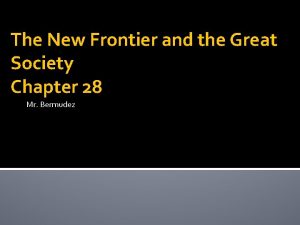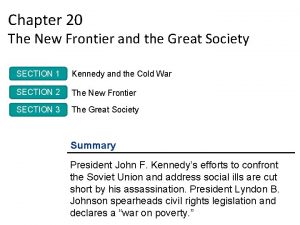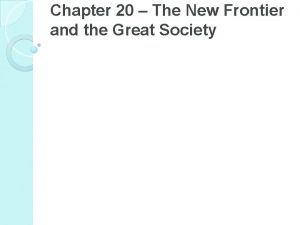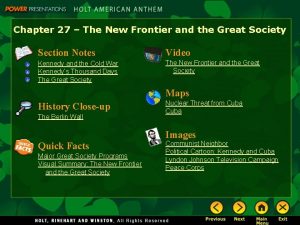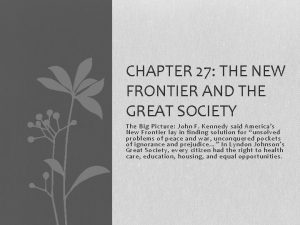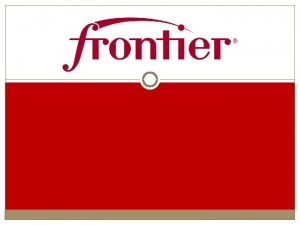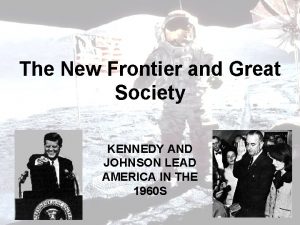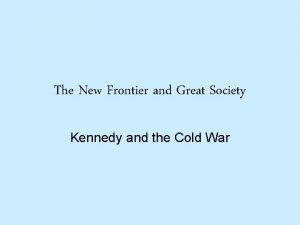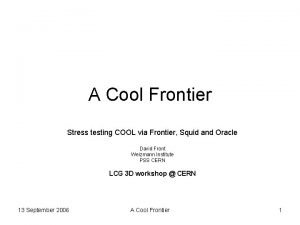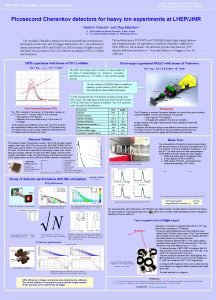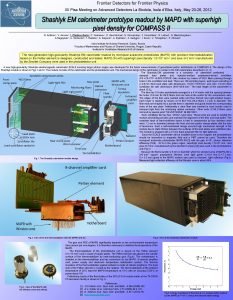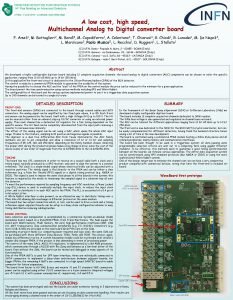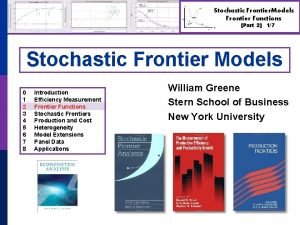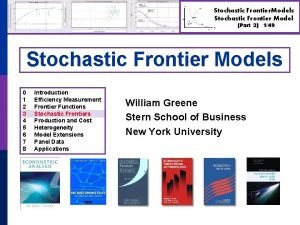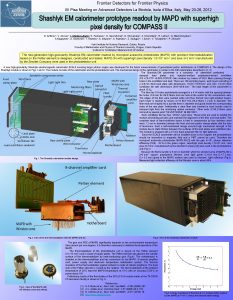Chapter 29 A New Frontier and a Great










































- Slides: 42

Chapter 29 A New Frontier and a Great Society, 1960 -1968 © 2016 W. W. Norton & Company, Inc.

JFK and Civil Rights © 2016 W. W. Norton & Company, Inc.

The New Frontier • Kennedy versus Nixon • In the 1960 election, vice-president Nixon was nominated for the presidency representing the Republicans, while the Democrats chose Senator John F. Kennedy (JFK). • Kennedy, who was sickly by nature, concealed his health issues through personal actions, much like Franklin Roosevelt (FDR) had. • This election was marked by the first televised debate between presidential candidates. This turned out to be the closest election since 1888; Kennedy received 303 electoral votes and Nixon 219, with only 118, 574 votes between them • The Vigorous New Administration © 2016 W. W. Norton & Company, Inc.

Space Race • After successes such as the launch of the Soviet satellite Sputnik in 1957, Kennedy pushed the race to put a man on the moon, nicknamed the “Space Race, ” by encouraging the growth in the studies of math and sciences in the public education system. © 2016 W. W. Norton & Company, Inc.

The Kennedy-Nixon Debates © 2016 W. W. Norton & Company, Inc.

The Election of 1960 © 2016 W. W. Norton & Company, Inc.

The New Frontier, continued • The Kennedy Record • JFK’s domestic program was called the New Frontier. He found many of his programs blocked by partisans in Congress. He did succeed in getting the Housing Act passed, which provided $5 billion for urban renewal over four years. • The Warren Court • The Supreme Court continued to be the decisive influence on domestic life in this era. The abolishment of prayer in schools, requiring a lawyer for every defendant regardless of ability to pay, and the notification of constitutional rights when being arrested are just some examples of landmark cases. © 2016 W. W. Norton & Company, Inc.

Foreign Frontiers • Early Setbacks • When JFK came into office, he learned of a plan to arm Cuban refugees, return them to Cuba, and have them overthrow Castro. • The plan, which landed the Cubans at the Bay of Pigs, ultimately failed. Two months after that, he met with Khrushchev, who bullied and threatened the inexperienced Kennedy. Upon returning home, JFK called up the Army Reserve and National Guard. The Soviets responded by erecting the Berlin Wall, dividing West and East Berlin. • The Cuban Missile Crisis- 1962, Soviet missiles were discovered in Cuba. They were put there to protect Castro from another attempted coup. JFK placed a blockade around Cuba, not allowing anything in or out until the missiles were removed. On October 24, Soviet ships stopped short of the quarantine line, and two days later, the Soviets agreed to remove the missiles. © 2016 W. W. Norton & Company, Inc.

Letter from Nikita Khrushchev to John F. Kennedy, October 26, 1962 © 2016 W. W. Norton & Company, Inc.

Black Saturday – Second Letter © 2016 W. W. Norton & Company, Inc.

U-2 Photo of Missile Site, October 14, 1962 © 2016 W. W. Norton & Company, Inc.

Severed Ties © 2016 W. W. Norton & Company, Inc.

Foreign Frontiers, continued • Kennedy and Vietnam • South Vietnam was still being supported by the might of the United States. However, the premier was showing an unwillingness to govern his people wisely or listen to American advice. As Communist forces continued to invade the south, Kennedy dispatched military advisers to the region to train the soldiers. In the fall of 1963, the United States supported a coup against the premier and he was murdered. • Kennedy’s Assassination • On November 22, 1963, JFK was assassinated by Lee Harvey Oswald in Dallas. © 2016 W. W. Norton & Company, Inc.

© 2016 W. W. Norton & Company, Inc.

Expansion of the Civil Rights Movement • Sit-Ins and Freedom Rides • Promoting their cause by nonviolent demonstrations, African Americans continued to protest the inequality of society. When four African American college students sat at a whites-only counter and refused to move, the concept of the “sit-in” was born. In 1961, to test a federal order banning segregation of buses, the Congress of Racial Equality sent groups of people on trips across the country to make sure the law was upheld. • Federal Intervention- In 1962, attorney general Robert Kennedy sent in troops to enforce a federal law abolishing segregation at the University of Mississippi when the governor refused to abide by it. The high point of the civil rights movement occurred at the March on Washington when Martin Luther King Jr. delivered his “I Have a Dream” speech. © 2016 W. W. Norton & Company, Inc.

© 2016 W. W. Norton & Company, Inc.

© 2016 W. W. Norton & Company, Inc.

Civil Rights and Its Peaceful Warriors © 2016 W. W. Norton & Company, Inc.

© 2016 W. W. Norton & Company, Inc.

Freedom Riders-On May 15, 1961, a white mob in Alabama assaulted a Freedom Bus, flinging fire bombs into its windows and beating the activists as they emerged. © 2016 W. W. Norton & Company, Inc.

Bull’s Dogs © 2016 W. W. Norton & Company, Inc.

“I Have a Dream, ” August 28, 1963 © 2016 W. W. Norton & Company, Inc.

From Civil Rights to Black Power • Freedom Summer • Civil Rights Legislation • Congress passed the Voting Rights Act of 1965, which ensured all citizens had the right to vote. It abolished literacy tests and other state policies designed at keeping African Americans from voting. © 2016 W. W. Norton & Company, Inc.

From Civil Rights to Black Power, continued • Black Power-A race riot in Watts, a neighborhood in California, led off a summer of racial violence in 1966. • Malcolm X- Groups of protesters supporting black power took to the streets, and one of their leaders was Malcolm X. He was assassinated by a rival faction of black Muslims in 1964. © 2016 W. W. Norton & Company, Inc.

II. The Second Reconstruction C. Black Power and Urban Rebellions • • • 1. Nationwide protest 1966, black protest extended from the South to the entire nation; protestors demanded not just legal equality but also economic justice; no longer held nonviolence as its basic principle; developments not entirely new, but the black freedom struggle began to appear more threatening to whites. 2. Unrealized promise 3. Violence in the cities Black rage at oppressive conditions erupted in waves of riots from 1964 to 1968; worst looting and damage occurred in Watts in August 1965; Newark and Detroit in July 1967; and Washington, D. C. , in April 1968; whites saw the riots as criminal activity. 5. Black Power movement SNCC chairman Stokely Carmichael gave a name to these new principles: “black power”; quickly became the rallying cry in SNCC and CORE; Carmichael rejected integration and assimilation because both implied white superiority; encouraged blacks to develop their own schools, communities, and organizations; according to black power advocates, nonviolence only brought more beatings and killings; after police killed an unarmed black teenager in San Francisco in 1966, Huey Newton and Bobby Seale organized the Black Panther Party for Self-Defense and armed its members for self-defense against police brutality. © 2016 W. W. Norton & Company, Inc.

Malcolm X © 2016 W. W. Norton & Company, Inc.

Lyndon Johnson and the Great Society • Politics and Poverty- Lyndon Johnson (LBJ) had been added to the ticket to provide balance to the inexperienced Kennedy. He continued Kennedy’s domestic program, and through his leadership had most of it passed. In 1964, he announced a war on poverty aimed at educating and elevating the nation’s poor. • The Election of 1964 - LBJ was nominated for president in 1964 and faced Barry Goldwater, a senator from Arizona. The result was a landslide, with LBJ winning 61 percent of the vote. © 2016 W. W. Norton & Company, Inc.

War on Poverty © 2016 W. W. Norton & Company, Inc.

© 2016 W. W. Norton & Company, Inc.

Lyndon Johnson and the Great Society, continued • Landmark Legislation • In 1965, LBJ got Congress to approve his Medicare program, which provided for health insurance for the aged. In the end, the Great Society generated 435 bills that would pass Congress. • The Immigration Act- The Immigration Act abolished the use of quotas in allowing people to immigrate to the United States. These quotas had been in effect since the 1920 s. • Assessing the Great Society © 2016 W. W. Norton & Company, Inc.

II. The Second Reconstruction B. The Response in Washington 1. Lack of initiative • • • Both the Kennedy and the Johnson administrations were reluctant to alienate southern voters and congressmen; tended to move only when civil rights activists gave them no choice. 2. The civil rights bill June 1963, Kennedy finally made good on his promise to seek strong antidiscrimination legislation; Civil Rights Act of 1964 guaranteed access for all Americans to public accommodations, public education, employment, and voting, thus sounding the death knell for the South’s system of segregation and discrimination. 3. The Voting Rights Act August 1965, Johnson signed the Voting Rights Act, which empowered the federal government to intervene directly to enable African Americans to register and vote, transforming southern politics. 4. Affirmative action Johnson issued an executive order in 1965 that required employers with government contracts to take affirmative action to ensure equal opportunity. 5. Combating neighborhood segregation Civil Rights Act of 1968 banned racial discrimination in housing and jury selection and authorized federal intervention when states failed to protect civil rights workers from violence. © 2016 W. W. Norton & Company, Inc.

© 2016 W. W. Norton & Company, Inc.

The Tragedy of Vietnam • Escalation- LBJ inherited the policy of preventing Communist supremacy in Indochina. He did not see any reason to “save” Vietnam, but since the United States was already committed, he saw no way to extricate the advisers. • On August 7, 1964, LBJ appeared on TV and informed the American public that the USS Maddox and USS Turner Joy had been fired on by North Vietnamese vessels in the Gulf of Tonkin. • He did not mention that they had been monitoring South Vietnamese attacks on North Vietnamese troops planned by American advisers. He asked Congress for a resolution authorizing the president to take all necessary steps to repel attacks against U. S. forces. He received it. By March 1965, combat troops began to arrive in Vietnam. © 2016 W. W. Norton & Company, Inc.

• The Context for Policy • LBJ’s decision to go into Vietnam was consistent with the foreign policies of all presidents back to Truman. At the time, military intervention was the logical next step for him to take. In a battle of wills, the North Vietnamese won, as public support in the United States eroded. © 2016 W. W. Norton & Company, Inc.

Vietnam, 1966 © 2016 W. W. Norton & Company, Inc.

The Tragedy of Vietnam, continued • The Turning Point • On January 31, 1968, the Viet Cong launched an attack on South Vietnam that was dubbed the “Tet offensive, ” due to it occurring on the Vietnamese New Year. • Although it was beaten back and was a staggering loss for the Viet Cong, the American public viewed it as a tremendous loss. LBJ’s popularity declined 35 percent, leading him to announce that he would not seek a second term on his own in the 1968 election. © 2016 W. W. Norton & Company, Inc.

Hidden © 2016 W. W. Norton & Company, Inc.

Whose War © 2016 W. W. Norton & Company, Inc.

Sixties Crescendo • A Traumatic Year- year 1968 was marked by tragedy. Martin Luther King Jr. was assassinated, along with Senator Robert F. Kennedy, who had just clinched the Democratic nomination for president. • Chicago and Miami- At the Democratic National Convention in Chicago, Mayor Richard Daley ordered 20, 000 police and national guardsmen to keep order, but when they could not, anxious reporters broadcast the riots across the nations. The Democrats eventually nominated Hubert Humphrey for president. The Republicans, at their convention in Miami, chose Richard Nixon. A third-party candidate, George Wallace, ran as an independent • Nixon Again- Nixon enjoyed a tremendous lead in the polls and won by 500, 000 votes, although it was not as close in electoral votes, 301 to 191. © 2016 W. W. Norton & Company, Inc.

© 2016 W. W. Norton & Company, Inc.

The Election of 1968 © 2016 W. W. Norton & Company, Inc.

This concludes the Lecture Power. Point presentation for Chapter 29 A New Frontier and a Great Society, 1960 -1968 Please visit the Student Site for more resources: http: //wwnorton. com/college/history/america 10/ © 2016 W. W. Norton & Company, Inc.
 Chapter 15 the new frontier and the great society lesson 1
Chapter 15 the new frontier and the great society lesson 1 Chapter 28 section 2 the new frontier
Chapter 28 section 2 the new frontier The new frontier and great society
The new frontier and great society Frontier detectors for frontier physics
Frontier detectors for frontier physics New frontier vs great society
New frontier vs great society New frontier vs great society
New frontier vs great society Chapter 20 section 2 the new frontier
Chapter 20 section 2 the new frontier Jfk assassination political cartoon
Jfk assassination political cartoon The new frontier fulfilled promises
The new frontier fulfilled promises New frontier camelot
New frontier camelot New frontier jfk
New frontier jfk New frontier camelot
New frontier camelot Kennedys new frontier
Kennedys new frontier Chapter 33 the great depression and the new deal
Chapter 33 the great depression and the new deal Chapter 16 toward a new heaven and a new earth
Chapter 16 toward a new heaven and a new earth Quantum computing and the entanglement frontier
Quantum computing and the entanglement frontier Depression/new deal unit vocab
Depression/new deal unit vocab What is the main idea of this cartoon?
What is the main idea of this cartoon? New york, new jersey, pennsylvania, and delaware
New york, new jersey, pennsylvania, and delaware Fresh oil, new wine scripture
Fresh oil, new wine scripture Strengths and weaknesses of the articles of confederation
Strengths and weaknesses of the articles of confederation New marketing realities pdf
New marketing realities pdf New classical macroeconomics
New classical macroeconomics Neil thisse is a loyalist who fled the colonies
Neil thisse is a loyalist who fled the colonies New classical and new keynesian macroeconomics
New classical and new keynesian macroeconomics Turning great strategy into great performance
Turning great strategy into great performance South dakota state animal
South dakota state animal Responsible leadership
Responsible leadership Hammerhead vs great white
Hammerhead vs great white Did alexander the great deserve to be called great
Did alexander the great deserve to be called great Enlightened despot catherine
Enlightened despot catherine With great expectations comes great responsibility
With great expectations comes great responsibility A great deal vs a great many
A great deal vs a great many With great power comes great responsibility batman
With great power comes great responsibility batman Did alexander the great deserve to be called great
Did alexander the great deserve to be called great Oh god my father how great great is your faithfulness
Oh god my father how great great is your faithfulness Obsolescent frontier civilization
Obsolescent frontier civilization Differentiate obsolescent “frontier” civilization
Differentiate obsolescent “frontier” civilization Ppc graph
Ppc graph Auxiliary dental definition
Auxiliary dental definition Mercator url frontier
Mercator url frontier Deadwood sd apush
Deadwood sd apush Strategic fit
Strategic fit
